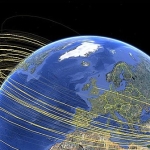Modernism
Modern life is unstoppable. Some characters in the novel, as the protagonist Henk van Wijnen-Swarttouw, wrestle with the pros and cons of the new technologies and social developments. Where others make good use of them or simply accept the given situation, Henk goes one step further: he tries to arrange it by his demands and whishes.
Technic
Unlike his eighteen year old daughter Julia – she grew up with social media – Henk is struggling with the effects of modern technology in everyday life, until he discovers new business intelligence software and sees endless possibilities. He buys this experimental software tool of Waldemar van Splunteren, a former forensic psychologist. This software can prevent tunnelvision and seems ideal.

Henk sees these new technical means as an opportunity and he would not be called Henk van Wijnen-Swarttouw if he does not apply these tools in his own way. For this purpose, he teams up with Edwin, a Rotterdam crime fighter and private detective. In his pursuit of a tilt Henk sees a role for the artist club of Julia. With art, he discoveres, you can achieve more than polish your personal status. For this purpose he seeks contact with Quinten, the artist working with his daughter. Together with his favourite journalist Eddy Hofs, they come up with a masterplan.
Meanwhile, Julia goes on experimenting and creating artistic expressions.
Modernism in art
 Modernism in art is the collective name for progressive and unconventional thinking in the first half of the 20th century. Modernist thinking was applied to all facets of art. The core idea is to think outside strict conventions and reject tradition. Unanimity in views among modernists hardly exists. Some modernists saw themselves as part of a revolutionary culture, but most were apolitical. Others, such as T. S. Eliot, rejected mass culture from a conservative standpoint. Some argued that modernism in literature and art functioned for the benefit of an elite culture which excluded the rest of the population. Although the historic avant-garde movements (such as expressionism, futurism, Dada and Surrealism) definitely belong to modernism, the term is also used for individual writers who were not part of any of those radical movements. For example, James Joyce, Virginia Woolf, T. S. Eliot, Marcel Proust, André Gide, Thomas Mann and Robert Musil are typical modernist writers. A characteristic of modernism in literature is the use of non-traditional techniques (such as Stream-of-consciousness in the novel and mounting in poetry) and the hyper-awareness that reality is recorded and interpreted. Modernist writers self-reflect in their creative work. They are aware that all perception and knowledge depends on the position taken. That’s why they put conventional frameworks on the slope and pierce them like familiar behavioral and perception patterns. Yet they are often looking for a new, comprehensive explanation of phenomena, they often look for meaningfullness – even though they realize that it will never be final. Postmodernism in the contrast, doesn’t feels the need for meaningfullness anymore.
Modernism in art is the collective name for progressive and unconventional thinking in the first half of the 20th century. Modernist thinking was applied to all facets of art. The core idea is to think outside strict conventions and reject tradition. Unanimity in views among modernists hardly exists. Some modernists saw themselves as part of a revolutionary culture, but most were apolitical. Others, such as T. S. Eliot, rejected mass culture from a conservative standpoint. Some argued that modernism in literature and art functioned for the benefit of an elite culture which excluded the rest of the population. Although the historic avant-garde movements (such as expressionism, futurism, Dada and Surrealism) definitely belong to modernism, the term is also used for individual writers who were not part of any of those radical movements. For example, James Joyce, Virginia Woolf, T. S. Eliot, Marcel Proust, André Gide, Thomas Mann and Robert Musil are typical modernist writers. A characteristic of modernism in literature is the use of non-traditional techniques (such as Stream-of-consciousness in the novel and mounting in poetry) and the hyper-awareness that reality is recorded and interpreted. Modernist writers self-reflect in their creative work. They are aware that all perception and knowledge depends on the position taken. That’s why they put conventional frameworks on the slope and pierce them like familiar behavioral and perception patterns. Yet they are often looking for a new, comprehensive explanation of phenomena, they often look for meaningfullness – even though they realize that it will never be final. Postmodernism in the contrast, doesn’t feels the need for meaningfullness anymore.
Julia is looking for a renewed sense of purpose through her artwork. But whether her father is the best person to support her in this?